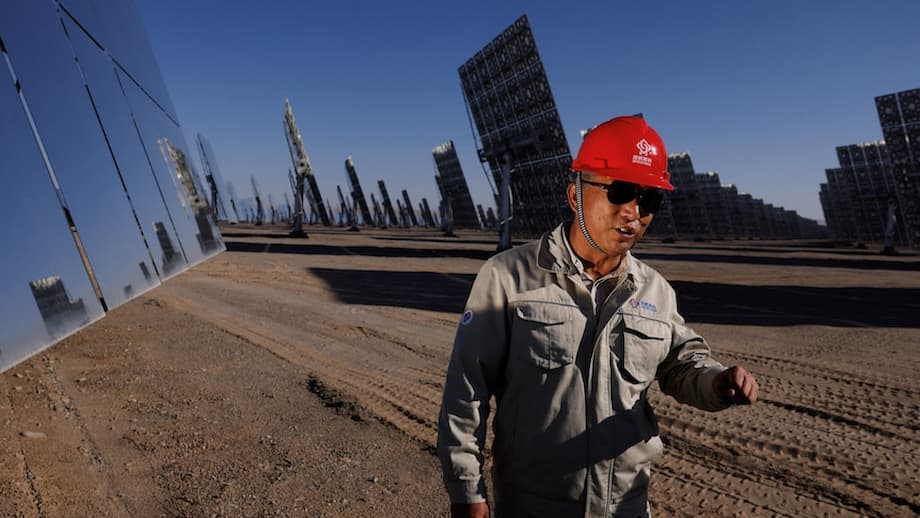China’s Carbon Emissions: A Historic Turning Point?
China, the world’s largest emitter of carbon dioxide, has reached a potential turning point in its battle against climate change. For the first time, the country’s carbon emissions have declined not because of an economic slowdown, but due to a dramatic surge in renewable energy. This development could have profound implications for global climate targets, the international coal industry, and the future of energy worldwide.
- China’s Carbon Emissions: A Historic Turning Point?
- What’s Behind the Drop? The Rise of Renewables
- Is This the Peak? The Debate Among Experts
- Coal: Still a Stumbling Block
- China’s Climate Policy: Ambition and Shortcomings
- The Role of Policy and International Dynamics
- Economic and Social Impacts: Winners and Losers
- Challenges Ahead: Can China Lead the World to 1.5°C?
- In Summary
In the year leading up to May 2025, China’s carbon dioxide (CO2) emissions fell by 1.6%, according to the Center for Research on Energy and Clean Air (CREA). This trend has continued in subsequent months, marking a historic shift for a nation that accounts for about 30% of global carbon emissions. Experts say this decline is unique—previous drops in China’s emissions only occurred during periods of economic distress, such as the COVID-19 pandemic or the global financial crisis. Now, clean energy is driving the change.
What’s Behind the Drop? The Rise of Renewables
The main driver of China’s emissions decline is a rapid and unprecedented expansion of renewable energy. In 2024 and 2025, China added more solar and wind power capacity than the rest of the world combined. In May 2025 alone, the country installed 90 gigawatts (GW) of solar capacity—equivalent to about 100 solar panels every second. Wind and solar capacity now surpass all thermal power capacity (including coal, gas, and oil) in China’s energy mix.
According to Carbon Brief, clean power generation growth has overtaken electricity demand growth for the first time. This means that even as China’s economy and energy needs continue to expand, the additional demand is being met by renewables rather than fossil fuels. In the first quarter of 2025, power-sector emissions fell by 5.8% year-on-year, and overall emissions dropped by 1.6% despite a 2.5% increase in power demand.
Belinda Schäpe, a policy expert at CREA, explained the significance:
“This is a historic result due to a rapid increase in renewables build-out in China, leading to more power generation from clean sources and reducing the coal share in the power mix, thus bringing down emissions.”
China’s clean energy push is not limited to domestic use. The country is also exporting renewable technologies and shifting its Belt and Road Initiative to focus on clean energy infrastructure in developing nations. In 2023, China’s exports of renewable products grew by 35%, and it now produces over 80% of the world’s solar panels, 60% of wind turbines, and 70% of electric vehicles.
Is This the Peak? The Debate Among Experts
While the recent decline in emissions is promising, experts caution that it is too early to declare a permanent peak. China’s emissions are currently just 1% below their most recent peak, so a short-term increase in energy demand or a slowdown in renewable installations could push emissions to new highs. The future trajectory will depend on several factors:
- China’s economic growth and energy demand
- The pace of renewable energy deployment
- Policy decisions in upcoming Five-Year Plans
- Global trade dynamics, especially US-China relations
Li Shuo, director of the China Climate Hub at the Asia Society Policy Institute, described the current period as a plateau:
“After decades of rapid economic and emissions growth, China has likely reached or is very close to its emissions peak. We are entering a phase of stabilization and large-scale integration of renewable energy, which could lead to further reductions.”
However, the United Nations Intergovernmental Panel on Climate Change (IPCC) warns that emissions must not only peak but also decline rapidly to keep global warming below 1.5 degrees Celsius. Stabilization alone is not enough to avoid catastrophic climate impacts.
Coal: Still a Stumbling Block
Despite the renewables boom, coal remains a significant part of China’s energy system. In 2022 and 2023, Beijing approved an average of two new coal-fired power projects per week, largely in response to power shortages and concerns about energy security. Many of these plants are now coming online, but they are using less coal than previous generations, and coal imports have dropped by 25% year-on-year in June 2025.
Coal’s share in China’s power mix has fallen to just over 50%, its lowest level since 2016. Renewables accounted for 24% of total electricity generation in the first half of 2025, and solar and wind met 89% of the growth in power demand in June. President Xi Jinping has pledged to phase down coal consumption between 2026 and 2030, but the transition is complicated by the economic importance of coal in several provinces.
Jorrit Gosens, a climate policy fellow at the Australian National University, highlighted the global ripple effects:
“China imports about 30% of Australian thermal coal exports. As China shifts to renewables and increases domestic coal supply, demand for Australian coal will fall. Other Asian markets are expected to follow as they decarbonize.”
China’s Climate Policy: Ambition and Shortcomings
China has set ambitious climate goals: to peak carbon emissions before 2030 and achieve carbon neutrality by 2060. The country has already surpassed its 2030 target for wind and solar capacity—reaching over 1,400 GW in 2024, six years ahead of schedule. China is also on track to achieve its non-fossil energy share target of 25% by 2030.
However, there are significant challenges. China missed its 2024 target for reducing carbon intensity (emissions per unit of GDP), achieving a 3.4% reduction instead of the planned 3.9%. The country is also behind on its goal to cut carbon intensity by 18% between 2020 and 2025. Rapid economic growth and surging energy demand have made it difficult to improve energy efficiency at the necessary pace.
The Climate Action Tracker rates China’s current policies and targets as “Highly insufficient” for meeting the Paris Agreement’s 1.5°C limit. While China is expected to overachieve its energy-related targets, it risks missing its carbon intensity goals. Experts argue that China needs to set an ambitious, economy-wide absolute emissions cap and accelerate the phase-out of coal to align with global climate goals.
David Fishman, a senior manager at the Lantau Group, an energy consultancy, noted:
“China has made remarkable achievements in renewable energy. But achieving carbon neutrality will require many more structural changes in China’s energy sector and economy as a whole, and those changes need to start soon after peak.”
The Role of Policy and International Dynamics
China’s energy transition is being driven by strong government support and strategic investment. President Xi Jinping’s governing ideology, known as Xi Jinping Thought, emphasizes the need for an “ecological civilization.” In 2021, China launched the world’s largest Emissions Trading Scheme, allowing firms to trade carbon allowances and incentivizing emission reductions.
China’s upcoming climate targets for 2026–2030, to be released alongside its next Five-Year Plan, will be crucial in determining the direction of both public and private sector efforts. The government is also introducing a new renewable electricity pricing policy, which has triggered a rush to install capacity before it takes effect. This policy shift is expected to lower prices for new wind and solar projects but creates uncertainty about future expansion rates.
Internationally, China’s climate actions are closely watched. The ongoing US-China tariff dispute and shifting US climate policies have complicated the global landscape. While the US has recently shifted from green energy subsidies to coal subsidies, China appears committed to its green agenda for its own economic and environmental interests. President Xi has stated that China will not slow down its climate actions, and the country is set to announce new climate targets under the Paris Agreement later this year.
Economic and Social Impacts: Winners and Losers
The shift to renewables is transforming China’s economy and has global repercussions. Clean energy technologies—especially electric vehicles, batteries, and solar power—now drive over 10% of China’s GDP, with investment and sales reaching nearly $2 trillion in 2024. China leads the global electric vehicle market, producing 70% of all EVs sold worldwide.
However, the transition poses challenges for regions and industries dependent on coal. The closure of BHP’s Mt Arthur coal mine in Australia is a stark example of shrinking demand. Experts warn that communities reliant on coal need support to transition to new industries, as resistance to change could lead to economic hardship.
China’s financial sector also plays a role. Research published in Frontiers in Environmental Science found that while economic and financial development have historically increased emissions, renewable energy adoption and investments in green technologies can decouple growth from pollution. Human capital and sustainable agriculture further contribute to emission reductions.
Challenges Ahead: Can China Lead the World to 1.5°C?
Despite the progress, China’s path to carbon neutrality is far from assured. The country’s energy demand continues to grow rapidly, and coal remains a political and economic force. Record heatwaves and droughts have disrupted hydropower, forcing authorities to rely on coal to meet electricity needs. The lack of an absolute emissions cap and the continued construction of coal plants raise doubts about China’s ability to meet its climate commitments.
Experts warn that the current pace of change may not be fast enough to limit global warming to 1.5 or even 2 degrees Celsius. The world’s ability to meet the Paris Agreement targets hinges on China’s actions. As the world’s factory, China produces more than a third of global manufactured goods and emits over a third of global CO2. Its choices will shape the future of the planet.
Nonetheless, China’s leadership in renewables and its commitment to new climate targets offer hope. The next few years will be critical in determining whether China can sustain its emissions decline and inspire other nations to follow suit.
In Summary
- China’s carbon emissions fell by 1.6% in the year to May 2025, driven by a surge in renewable energy capacity.
- This marks the first time emissions have declined due to clean energy rather than economic downturns.
- China leads the world in solar, wind, and electric vehicle production, and has surpassed its 2030 renewables target six years early.
- Coal remains a significant part of China’s energy mix, but its share is declining as renewables grow.
- China missed its 2024 carbon intensity reduction target and faces challenges in meeting its 2025 and 2030 climate goals.
- The transition to clean energy is reshaping global coal markets, especially for exporters like Australia.
- China’s upcoming climate policies and international cooperation will be crucial for global efforts to limit warming to 1.5°C.
- Experts emphasize the need for continued structural reforms and absolute emissions caps to ensure lasting progress.




